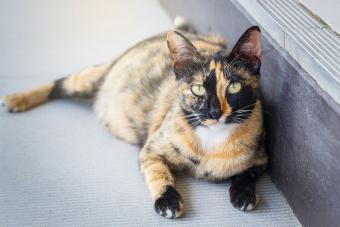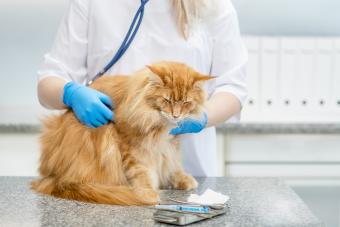
When your feline friend gets a whiff of catnip, it's like a ticket to the 'purr-ty' zone! Catnip can work its magic in various ways, whether your kitty sniffs it or nibbles on it. And how it affects your cat's brain is downright cool. But remember, not all cats dance to the same 'meow-sic.' Catnip is safe in moderation and can turn playtime into a 'pawsome' adventure.
Researchers found that 30-50% of cats don't appear to respond to catnip. If your cat doesn't, you can try silver vine or valerian instead.
What Is Catnip?
Catnip is a plant, also known as Nepeta cataria, and a member of the mint family. The plant grows wild worldwide and can be identified by its heart-shaped leaves, stems with fine green hairs, and white and purple flowers. The stems and leaves of the catnip plant contain nepetalactone, which is the chemical that makes cats react so strongly to it.

What Does Catnip Do to Cats?
When a cat sniffs catnip, you might see them engage in some funny, animated behaviors, like:
- Rubbing against the catnip with their heads or full bodies
- Rolling on top of the catnip or just rolling around in general
- Drooling and salivating excessively
- "Talking" more than usual with meows, chirps, howls and purrs
- Rapid movements, pouncing, and hyperactive running around
- Aggressive behavior may show up with some cats toward either you or other pets in the home
If a cat eats catnip, they'll have a much more sedative response, and you may notice them become sleepy and lethargic instead of hyperactive.
How Long Does Catnip Last?
The effects of catnip wear off pretty quickly and only last for about 10 to 15 minutes. But offering more catnip after that short time won’t really do anything because, interestingly enough, cats become temporarily immune to catnip for at least 30 minutes afterward.
Why Does Catnip Affect Cats?
Science time. When a cat's vomeronasal gland in their nose comes into contact with the nepetalactone in catnip, it causes a reaction in the olfactory bulb's neurons. This causes the cat's amygdala and hypothalamus, two regions of the brain, to respond.
In layman's terms, each cat responds to catnip differently, but the nepetalactone sometimes acts as a pheromone would in your cat's body. These cats will respond with behaviors you would normally see with a female cat in heat. Other cats appear to have a slight hallucinatory reaction. That said, we can't "see" what our cats see when they have catnip, so exactly what they're feeling is still a guess.
Why Do Cats Like Catnip?
The behaviors that catnip produces appear to suggest your cat’s feeling a sense of euphoria — or even arousal. But since we’re not in our cat’s heads, we can’t be absolutely sure. What we know is cats appear to love the stuff. Don’t worry, catnip’s not addicting and doesn’t lead to any long-term side effects for your cat.
Never force your cat to smell or consume catnip. It should always be their choice.

Depending on how a cat reacts to it, catnip might help an anxious cat relax and could assist shyer cats in feeling more confident when engaging with people. It’s also been believed to have some antispasmodic properties, which can help cats with gastrointestinal issues.
Potential Benefits of Catnip Play
Catnip isn't just fun and beneficial for us — a belly laugh can be therapeutic, but catnip play can also be great for cats who react well to it.
Stimulate Exercise
Catnip can be an excellent motivator for any cat who needs to get some exercise. If catnip has an active effect on them, offer some, then watch your cat get up and move around with joy. You can pair it with some cat toys to get a lazier cat in the mood to play and break out some cardio moves.
Relieve Stress
Catnip can be useful for cats that are anxious or stressed, especially around specific events. If you have a cat that doesn't want to go into a carrier to go to the veterinarian, sprinkle some catnip in the carrier to create a positive association with the carrier. It can also entice some cats who are too nervous to come out and play and is great for relieving general boredom, which can lead to stress if left unaddressed.
Never give your cat catnip prior to travel or new experiences, as it can cause an aggressive effect in some cats.
Does Catnip Affect All Cats?
The response to catnip is actually a genetically inherited trait that can be found in about 50 to 75% of cats. Cats who don't have the trait might simply ignore the catnip and show no noticeable response.
However, a study published in 2017 in Behavioural Processes found that almost 100% of cats responded to catnip, either reacting with active behaviors (the typical "heat" behaviors) or passive responses. Most of the cats had a passive response where they became quiet and sat in a "sphinx-like posture" when given catnip. Again, we won't know the full truth of this until the day we can ask our cats, but if your cat doesn't appear to like catnip, silver vine and valerian can have similar effects.
Is Catnip Safe for Cats?
Catnip is perfectly safe to use with your cat, although it's best in moderation. A cat that's overexcited could hurt themselves or even overexert themselves if they're overweight. If you give catnip to your cat to eat, only give them a tiny portion at a time, as too much of it can cause vomiting, diarrhea, and other gastrointestinal upset.
If you have more than one cat, it's best to give catnip to each cat individually and monitor them for any aggressive responses. Sometimes, it can make cats hostile to each other, so it's better to give multiple cats their own private nip sessions.
Is Catnip Bad for Kittens?
Catnip also doesn’t appear to have any effect on kittens under the age of six months, even if they have the inherited catnip gene. This may be because they’re not yet sexually mature. But is it bad for them? Most experts say, no, catnip won't harm a kitten, but they won't react to it either. Save the catnip for when they're a little older, instead.
How to Give Cats Catnip
Is your cat one of the ones that absolutely loves catnip? There are several ways that you can use catnip to give your cat some fun and enrichment.

Buy Catnip Toys
Many manufacturers will stuff some catnip inside soft toys to make them attractive to cats. A cat chewing on its catnip toy is a happy cat indeed! Just know catnip toys have a very short play-life, so you may have to replace them often. Look for toys that have zippers and other openings that allow you to stuff fresh new catnip in and remove the old stuff that your kitty may have drooled on.
You can "marinate" your cat's toys in a jar of catnip to give them a fresh pick-me-up. Simply rotate the toys in and out of the jar and watch your cat treat it like new!
Buy Dried Catnip
You can buy loose catnip and crumble some on the ground for your cats to enjoy. They'll roll in it, lick it off their coats, mush their faces in it, and act like drunken fools. The buzz only lasts for a short time, and then they become saturated and indifferent to the herb for a while until their sensors reset, and they can enjoy it again.
Make Your Own Catnip Toys
Stuff the end of an old sock with some catnip and either tie it off with a knot or sew it shut. This can become a kind of comfort-toy for your pet, and they may carry it from place to place or even sleep with their head on it like a pillow.
Put Catnip on a Scratching Post
Getting your cat to use a scratching post is an excellent way of providing a healthy method for keeping their claws trimmed while saving your furniture. Some cats may not understand the purpose of a scratching post right away, so sprinkling catnip on it can help entice cats to rub up against the post and claw it.
Use Catnip in Treats
Catnip is safe for cats to eat, and it can provide cats with a calming sensation. Why not sprinkle some catnip into homemade cat treats? Just make sure not to use too much, which can upset your cat's tummy. With the right recipe, our kitty will devour the treats and then curl up for a nice, relaxing nap.
Grow Your Own Catnip
Yes, you can grow your own catnip! Plant catnip from seed or find a catnip plant at your local nursery. Harvest the tops of the plant when it flowers and tie them in bundles to dry, hanging head-down. Make sure the bundles are hung well out of reach of your cat because some cats will scale any height to get to it! This means you'll need to make sure there are no handy items of furniture that the cat can use as a launching pad.
Store the dried herbs in a plastic tub with a tightly fitting lid since a sealed plastic bag doesn't provide enough protection for the catnip-hungry cat. Even in a tub, you may have to keep it in the refrigerator to keep cats from trying to bat the container open.
Catnip Makes Cats Happy
Don't be concerned if your kitty becomes a bit wild when presented with catnip. Cats seem to enjoy the sensations they get from the herb, and it's a good source of play, enrichment, and stress relief for cats. It's safe for them to eat as well and provides a calming effect. Test out a bit to see how your cat reacts, then consider adding it to their playtime plans.







